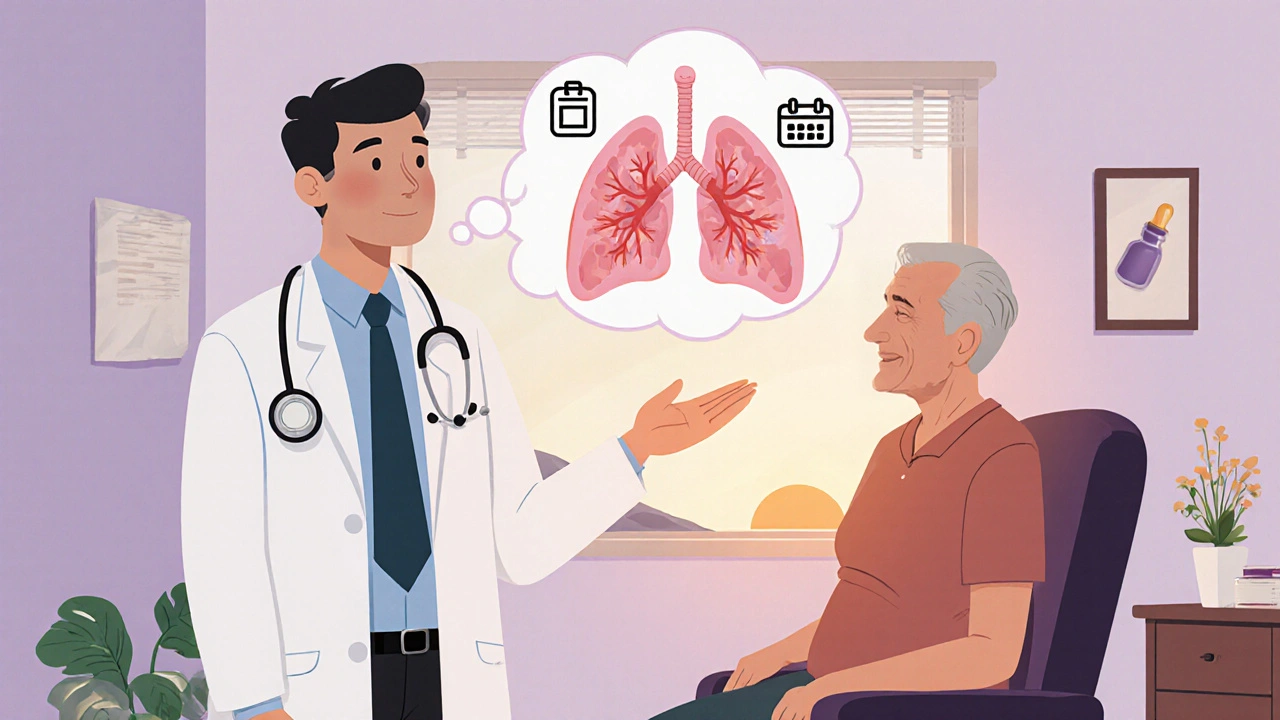nintedanib comparison: what you need to know
When looking at nintedanib comparison, a side‑by‑side look at the lung‑fibrosis drug nintedanib and its alternatives. Also known as Ofev, it helps slow down scarring in the lungs. Nintedanib is a tyrosine‑kinase inhibitor approved for idiopathic pulmonary fibrosis (IPF), and it’s often weighed against Pirfenidone another FDA‑approved antifibrotic medication. This comparison also touches on liver‑function monitoring a safety step required for both drugs and the impact on quality of life for patients living with progressive lung disease.
Why a focused nintedanib comparison matters
Idiopathic pulmonary fibrosis is a relentless disease that steals breathing capacity and limits daily activities. Because the condition progresses quickly, doctors and patients need clear data on how each drug changes the trajectory. In a nintedanib comparison, efficacy, side‑effect profile, and real‑world tolerability become the three pillars of decision‑making. The first pillar, efficacy, is measured by how much a drug slows forced vital capacity (FVC) decline. The second pillar, safety, looks at liver‑enzyme spikes, gastrointestinal upset, and drug‑drug interactions. The third pillar, patient‑reported outcomes, ties directly to quality of life. Together these pillars shape a practical roadmap for anyone facing an IPF treatment choice.
Understanding how nintedanib works is the next step. As a tyrosine‑kinase inhibitor, it blocks multiple growth‑factor receptors that drive fibroblast proliferation and collagen deposition in lung tissue. Clinical trials showed an average 50‑percent reduction in the rate of FVC decline compared with placebo. The drug is taken twice a day with food, and steady‑state levels are reached within a week. Because the mechanism targets several pathways, nintedanib often shows broader activity in patients with combined pulmonary fibrosis and emphysema, a subgroup that pirfenidone may not address as well.
Pirfenidone, on the other hand, works mainly by reducing oxidative stress and down‑regulating cytokine production. Its trial data reported a 30‑percent slowdown in FVC loss, slightly less than nintedanib but still clinically meaningful. Pirfenidone is dosed three times daily, which can be a hassle for some patients. The most common side effects are nausea, rash, and photosensitivity, while liver‑enzyme elevation is less frequent than with nintedanib. When you line up the two drugs, the comparison often comes down to speed of efficacy (nintedanib) versus pill burden and tolerability (pirfenidone).
Safety monitoring is where the comparison gets concrete. Both drugs require baseline liver‑function tests and regular follow‑up every 2‑4 weeks during the first three months. Nintedanib tends to cause higher rates of diarrhea and liver‑enzyme spikes, so clinicians may need to adjust the dose or add antidiarrheal medication. Pirfenidone’s chief safety concern is photosensitivity; patients must use sunscreen and avoid prolonged sun exposure. For patients on anticoagulants or with a history of bleeding, nintedanib’s inhibition of platelet‑derived growth factor can raise bleeding risk, making pirfenidone a safer alternative in that scenario.
Cost is a reality check that can tip the scales. Nintedanib’s list price in the United States hovers around $9,000–$10,000 per year, while pirfenidone sits slightly lower, around $7,500 annually. Insurance coverage varies, and some health plans require prior authorization that favours one drug over the other based on formulary status. Generic versions are not yet available for either medication, but patient‑assistance programs from manufacturers can reduce out‑of‑pocket expenses. When budgeting, remember to add the cost of monitoring labs and any supportive meds for side‑effect management.
From the patient’s perspective, the ultimate goal is to keep breathing easier and stay active longer. Studies that track patient‑reported outcomes show that both drugs improve quality‑of‑life scores, but nintedanib’s stronger effect on lung‑function often translates into a slower decline in six‑minute walk distance. However, those who can’t tolerate the twice‑daily dosing or who experience severe diarrhea may find pirfenidone’s less aggressive side‑effect profile more sustainable. The best approach is a shared decision‑making conversation that weighs each pillar—efficacy, safety, cost, and lifestyle impact—against personal priorities. Below you’ll find a curated set of articles that dive deeper into each of these aspects, offering practical tips, recent trial data, and real‑world experiences to help you choose the right path.
Esbriet (Pirfenidone) vs Other IPF Drugs: Full Comparison Guide
A detailed comparison of Esbriet (pirfenidone) with nintedanib and other IPF treatments, covering efficacy, side effects, dosing, cost and practical tips.
Read more
